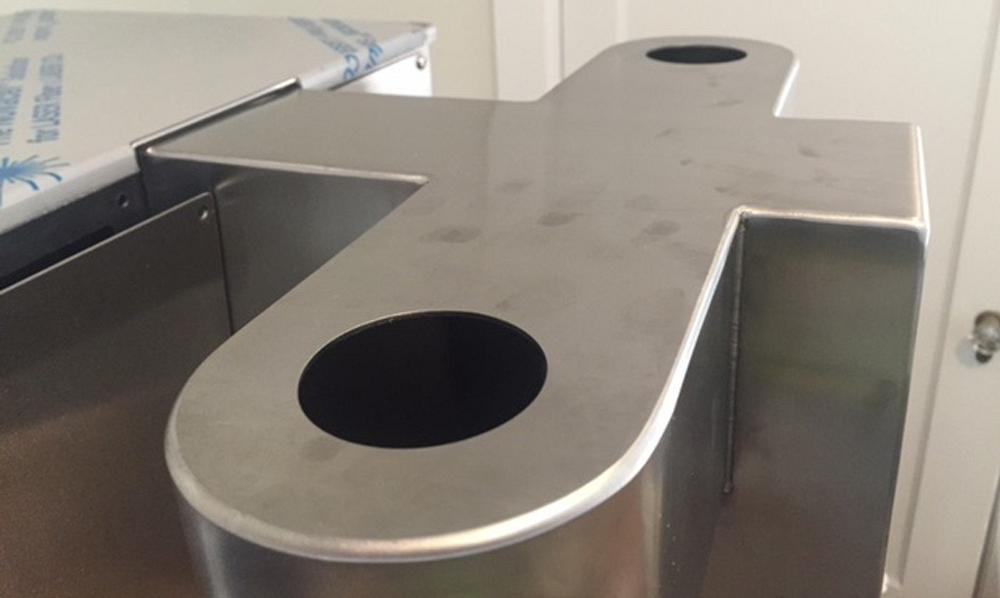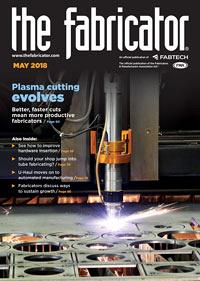Contributing Writer
- FMA
- The Fabricator
- FABTECH
- Canadian Metalworking
Categories
- Additive Manufacturing
- Aluminum Welding
- Arc Welding
- Assembly and Joining
- Automation and Robotics
- Bending and Forming
- Consumables
- Cutting and Weld Prep
- Electric Vehicles
- En Español
- Finishing
- Hydroforming
- Laser Cutting
- Laser Welding
- Machining
- Manufacturing Software
- Materials Handling
- Metals/Materials
- Oxyfuel Cutting
- Plasma Cutting
- Power Tools
- Punching and Other Holemaking
- Roll Forming
- Safety
- Sawing
- Shearing
- Shop Management
- Testing and Measuring
- Tube and Pipe Fabrication
- Tube and Pipe Production
- Waterjet Cutting
Industry Directory
Webcasts
Podcasts
FAB 40
Advertise
Subscribe
Account Login
Search
A 3-D CAD modeling case study: What the prototype reveals
The coffeemaker looked great, but what about the removeable cover and the undersized doorway?
- By Gerald Davis
- May 8, 2018
- Article
- Shop Management

Figure 1
The Ground Control coffee brewer made its debut at a tradeshow in Atlanta. The glass globes are part of the patented vacuum extraction of coffee from the bed of grounds.
Disclaimer: This case study of a coffee maker’s sheet metal cabinet features a pair of inventors doing their best without the benefit of experience in manufacturing.
The previous edition of this column (“A great industrial design can be burdened with inadequate planning,” Precision Matters, The FABRICATOR®, April 2018, p. 36) discussed some of the consequences of delegating significant design for manufacturing (DFM) work. Those consequences included difficulty with revision to the design and related documents.
In the story so far, a working prototype machine was demonstrated at a specialty coffee tradeshow in Atlanta (see Figure 1). Because tradeshow attendees showed strong interest in how the machine functioned, the brewers decided to refine the design for commercial production. That refined design would be presented at the next annual tradeshow. The goal was to be ready to ship equipment within 12 months.
From the experience of assembling the prototype for the Atlanta show, our inventors realized that the cabinet fabrication needed many changes. Figure 2a shows the sheet metal framework after the first test fit.
The 3-D CAD sent out for RFQ and subsequent fabrication left it up to the sheet metal shop to determine how to seam and weld the assembly. The cabinet in Figure 2a strongly resembled the STEP file. That was good and bad. Mostly bad.
Figure 2b shows a finely crafted weldment in thin sheet metal. It’s nicely grained, and everything is pretty flat. Not only does it represent fine craftsmanship, it is dimensionally very close to perfect.
The cover was supposed to be removable, however. Also, the closed-corner welds were left with blue discoloration from the welding torch. For the show in Atlanta, the team used a reciprocating saw to cut off the top that was supposed to be a cover. As a result, the public wasn’t encouraged to look down at the top of the machine.
Some beauty was lost in dressing out the welds, but for the show, it was enough. For production, however, a better system for service covers was a high priority.
Other misfires could be found in the design, as well. Figure 3a shows a welded brew basin. The exotic tubing and filters in the system are critical to the coffee maker’s operation. The parts didn’t need to be that heavy, but something similar was needed for the production models. This machine brews a lot of coffee, about 3 gallons per hour, so a large brew basin was required.
In Figure 3b the brew basin rests on slides inside the cabinet. It looks OK, but Figure 3c reveals that the front door frame isn’t wide enough to let the basin get into position. For the show, a smaller basin was used, and the 3-gallon production rate was not met. Not many people noticed. For future production, a match between basin and cabinet size was a high priority.

Figure 2a
Be careful what you ask for! The sheet metal cabinet pretty much matched the STEP file sent out for RFQ and fabrication.
Our heroes reviewed their business plan and found it to be on track. The tradeshow had generated interest in the machine. They felt they had a good look. The industrial design (ID) investment was worthwhile. They also were certain that their patented chemistry was a winner.
The problems were with cost of fabrication and basic stuff like the function of doors and slides. They now were faced with taking orders and delivering machinery.
The Next Step
They found my expertise in DFM by searching online using keywords like sheet metal and Solidworks. They called at a perfect moment. I was delighted to help with their DFM effort. My help also turned out to be a mixed blessing for them. Mostly good, it turns out. But that’s a story for a future edition.
My approach to this project was to create a detailed virtual prototype in CAD (see Figure 4). That CAD model corrects problems with doors that swing, basins that slide, levers that work, and service covers that don’t rely on sheet metal screws.
In the next episode we’ll compare Figure 4 to Figure 1 to reveal where the DFM tread heavily on the ID. It’ll be a DFM versus ID battle royale. Sonny Curtis’ “I Fought the Law” is a very apropos song for this tale.
Here’s the moral of the upcoming story: If you hang out your shingle as a DFM expert-for-hire, be sensitive to the importance of others’ ID.
Gerald would love for you to send him your comments and questions. You are not alone, and the problems you face often are shared by others. Please send your questions and comments to dand@thefabricator.com.
About the Author
subscribe now

The Fabricator is North America's leading magazine for the metal forming and fabricating industry. The magazine delivers the news, technical articles, and case histories that enable fabricators to do their jobs more efficiently. The Fabricator has served the industry since 1970.
start your free subscription- Stay connected from anywhere

Easily access valuable industry resources now with full access to the digital edition of The Fabricator.

Easily access valuable industry resources now with full access to the digital edition of The Welder.

Easily access valuable industry resources now with full access to the digital edition of The Tube and Pipe Journal.
- Podcasting
- Podcast:
- The Fabricator Podcast
- Published:
- 04/16/2024
- Running Time:
- 63:29
In this episode of The Fabricator Podcast, Caleb Chamberlain, co-founder and CEO of OSH Cut, discusses his company’s...
- Trending Articles
Tips for creating sheet metal tubes with perforations

JM Steel triples capacity for solar energy projects at Pennsylvania facility

Are two heads better than one in fiber laser cutting?

Supporting the metal fabricating industry through FMA

Omco Solar opens second Alabama manufacturing facility

- Industry Events
16th Annual Safety Conference
- April 30 - May 1, 2024
- Elgin,
Pipe and Tube Conference
- May 21 - 22, 2024
- Omaha, NE
World-Class Roll Forming Workshop
- June 5 - 6, 2024
- Louisville, KY
Advanced Laser Application Workshop
- June 25 - 27, 2024
- Novi, MI




























